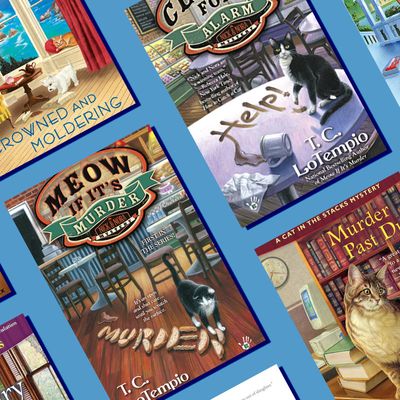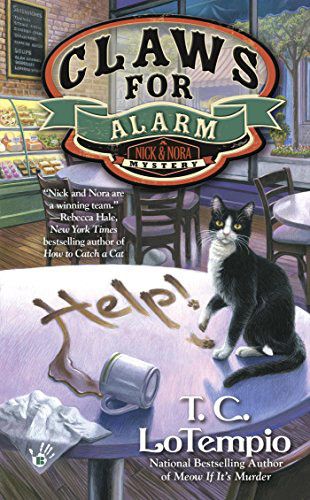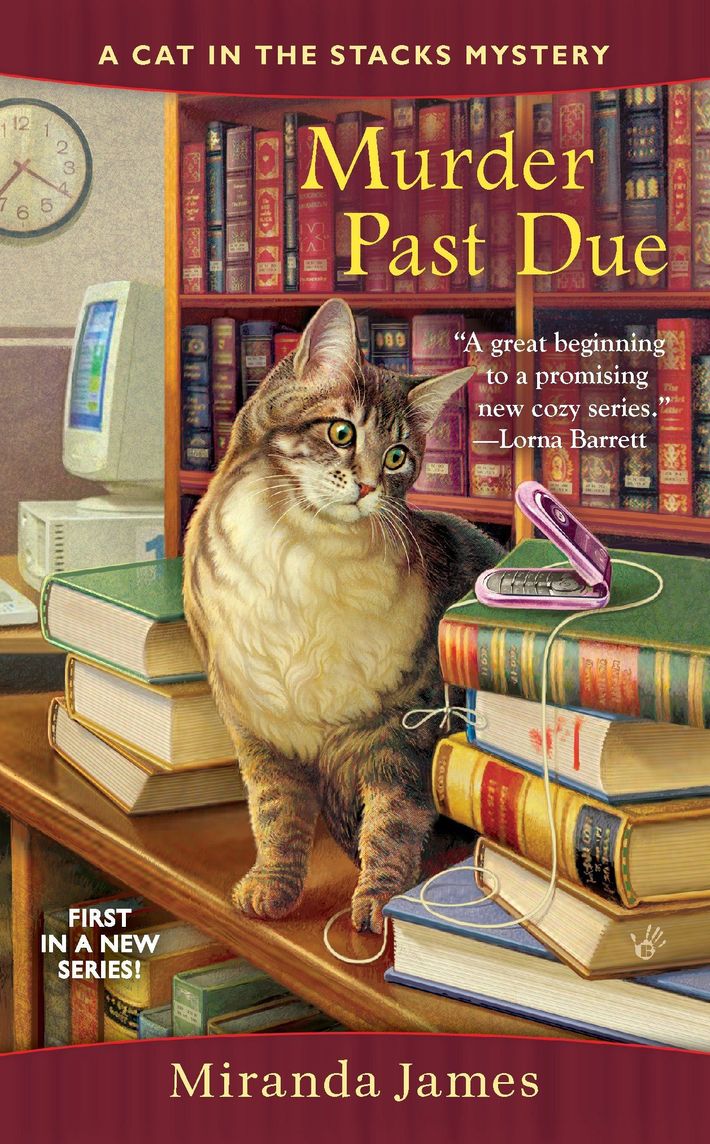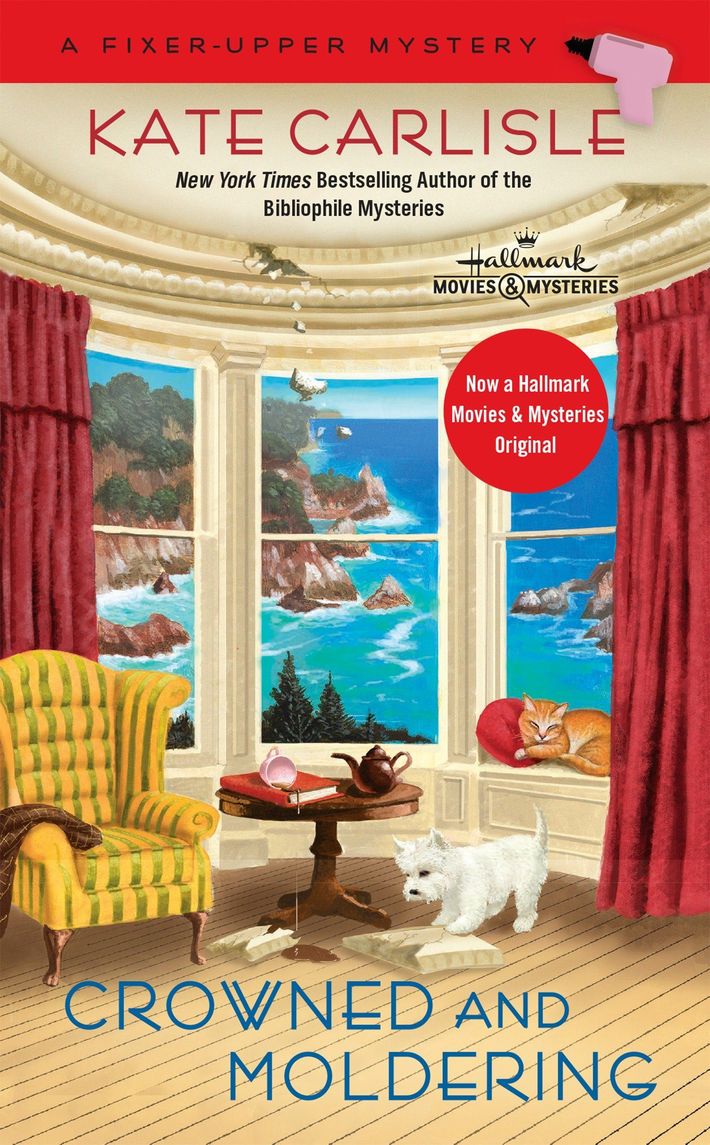
The day after my daughter was born, she was whisked off to the NICU after nurses noticed a funny little wheeze every time she took a breath. Her (blessedly) quick birth had left her with fluid in her lungs, something a few days of oxygen support would clear up. But the maternal fantasy of a perfectly healthy baby, swaddled and in our blissful arms, left me bereft over my tubed and taped up newborn. On a quick dash down to the hospital’s snack shop, my husband and I sat quietly, quickly shoving chips into our mouths before we returned to her bedside. A literary creeper by nature, I leaned forward to make out the title of the novel that a gray-haired woman read alone at her table.
The cover, illustrated with a black-and-white tuxedo cat spelling out M-U-R-D-E-R with the dozen or so biscotti littering the floor of a bakery, was one of the wonders of the modern world. It smacked my husband and me out of our slump and launched us into fevered whispering.
“So do the cats solve the mysteries?”
“Or maybe the cats are the villains?”
“No, no, no, look — that cat is obviously helping by spelling out murder.”
Okay, I live in a literary bubble, overburdened with galley copies of forthcoming novels from big publishing imprints; reading anything outside my to-do list is a rare event. (I’m very happy here, btw. Please do not disturb.) I’d certainly seen cozy phenom Rita Mae Brown’s paperbacks (Tail Gait; A Hiss Before Dying) on the shelves of my local grocery. But I was proverbially knocked on my ass when, a few months later, I saw a grouping of three tall, steely Barnes & Noble bookshelves crammed with dozens of cat-detective series — along with other titles that fall under the subgenre of “cozy mysteries.” An entire reading universe had been hiding from me in plain sight. I pawed my way in. (Yes, I’m going to do this.)
That helpful kitty we spotted in the hospital cafeteria turned out to dwell in a vast ecosystem. There are Laura Childs’s Tea Shop Mysteries (Death by Darjeeling, etc.), set in the mossy streets of Charleston, where teahouse owner Theodosia Brown solves local murders over a cuppa Earl Grey. Lorna Barrett’s Booktown Mysteries (Murder Is Binding) feature Tricia Miles of Stoneham, New Hampshire, proprietor of the Haven’t Got a Clue bookstore and — of course — amateur detective. There are 28 titles in Susan Wittig Albert’s China Bayles “herbal mysteries” series (starting with Thyme of Death, published in 1992). China is an “herbalist and ex-lawyer” who solves crimes with her New Age shop-owning best friend. In the Fixer Upper Mystery series, by Kate Carlisle (Crowned and Moldering; Eaves of Destruction), Victorian-home-restoration expert Sharon Hammer finds bodies and secrets in the walls of her projects. (Look for TV adaptations on the Hallmark Channel.)
All of these writers work under various aliases or produce multiples series. Laura Childs also writes a series about scrapbooking villainy (Fiber & Brimstone). Lorna Barrett writes about crafting criminality, too, under the pseudonym Lorraine Bartlett (A Crafty Killing); there is also a companion recipe book (Recipes to Die For, obviously). Under the name Robin Page, Susan Wittig Albert has published an Anglophilic Victorian/Edwardian mystery series with her husband (Death at Blenheim Palace).
“Cozy mysteries” share an unspoken mission — to lull readers with snug, idyllic settings; to offer murder and treachery without gore or shock; to wipe away that glaze of trauma with which traditional detective stories leave us slicked. Corpses are glanced over quickly, with little to no mention of blood or guts or rot. Forensics, fingerprints, and computer analyses are abandoned in favor of sleuthing so old-fashioned that a monocle wouldn’t seem out of place. The detectives are amateurs — busybodies who find themselves unwittingly drawn into crimes that are rendered in the language of a garden-party faux pas. The small-town settings are the sorts of places — neighborly and congenial, with a cozy café and thriving bookshop, and only minor tiffs related in gossipy asides — where murder is entirely unexpected, and yet the per capita homicide rates reach shocking proportions by book five or six. (Not unlike Cabot Cove, home of the great cozy TV mystery Murder, She Wrote, which the BBC determined to have a murder rate 60 percent higher than the most dangerous country in the world.) These books offer just enough horror to titillate readers — in a safe, comfy, congenial world.
There is a meta-formula to these formulaic books. Take any comfortable, domestic interest. Add one body, a few long-held small-town secrets, and a plot you could sell by the foot. Bam. You have a cozy mystery. Filter it all through a pun generator and you have a party game. How about a cross-stitching sleuth? A Stitch in Time Saves Nine. Gardening? Dig Deep. Tarot cards? That thing could write itself.
But the cat mystery novels are, well, a special breed. (Yep, I’m still doing it.) Before you ask: Yes, sometimes (as in Meow If It’s Murder, where feline Nick spells out clues with Scrabble letters), the cats do help solve the mysteries. But for the most part, they’re loyal sidekicks to their companions, furry Watsons who act as sounding boards for theories. Small-town mysteries are an obvious, watery counterpoint to increasingly blood-drenched thrillers. But cat mysteries tack on an even snugger appeal.
Take one representative sample, written by Miranda James (the alias of Dean James, and one of the few men I identified among the major authors in this canon). In Murder Past Due, James’s first “Cat in the Stacks Mystery,” we meet Diesel, the 35-pound Maine coon companion to Charlie Harris, an amiable librarian in the small college town of Athena, Georgia. Harris finds himself ensnared in a murder inquiry when Godfrey Priest, a rich and arrogant novelist who also grew up in Athena, is found dead in his hotel room after visiting the college to bequeath his papers to the library. Whodunit? Charlie’s boarder, Justin, who recently discovered he’s Godfrey’s son? His mother, Julia, Godfrey’s one-time fling? Or one of the other Athena residents who turn out to have long-standing grudges against the cocksure Godfrey? Diesel trots along next to Charlie on his trusty leash as they visit the town gossip and search Godfrey’s paper for clues. He’s an emotional-support animal for the dutifully woeful Justin. And, most importantly, he’s a sidekick who stays quiet (minus strategically timed purrs) and renders Charlie even more unassuming and folksy than he already is.
Murder Past Due’s entire plot could play out precisely the same way without Diesel. Instead, here and in the other cat mysteries, the felines are homey accessories — jolly little furballs who add a layer of comfort to an already sedate and orderly world. Yes, there’s a dead body — but with a fuzzy little creature purring on the sideline! The murders, meanwhile, aren’t really deaths. They’re inconveniences that at most elicit gasps and a couple tears, and little brain teasers for the detectives to quietly muse over with the same intensity you might apply to the Thursday crossword.
Most of contemporary mystery fiction casts these books in stark relief. Cat mysteries, and more broadly all cozy mysteries, are descended from the Agatha Christie branch of the mystery tree — more detective- than suspect-focused, mannerly in the face of brutality, trim, and entirely external in their estimations of character. Today’s glut of bleak, violent Scandinavian crime dramas and mental-illness-driven American domestic thrillers, on the other hand, belong to the school of Patricia Highsmith, where the root of the novel lies in the why and not the who, and brains on the carpet are practically a prerequisite.
A great swath of popular crime fiction is growing darker by the year, more and more interested in churning up the sediment gumming up the darkest reaches of our psyches. Seemingly every game of cat and mouse ends with both creatures disemboweled. It’s a genre of escapism from which you may urgently want to escape.
So is it any surprise that the best-seller list of mass-market paperbacks overflows with the literary equivalent of a cup of hot soup and some crusty bread? More than mysteries, these stories are fantasies: Of the ebb and flow of small-town life, with only the occasional spice of a little light murder; of Mayberrys whose crimes are ever-so-fascinating and inconsequential; of ordinary citizens maintaining civility and order in a world untouched by the tragedy of the commons. Of a life, alone with a cat, that is rich and textured and lively.
Nor is it any surprise that a cat mystery made its way into a hospital cafeteria, where it could offer quiet comfort. (In fact, they sell a ton of them in hospital gift shops.) They’re catnip for the soul! No claws for concern.
More From This Series
- A Very Simple Guide to True Detective’s Multiple Timelines
- True Detecting True Detective: Let’s Lay Odds on Who the Killer Is
- Extremely Wicked Director on How Ted Bundy ‘Seduced’ His Victims
- The Ocean’s Effect: How the 2001 Film Changed the Heist Movie For a Generation
- Why Is TV So Addicted to Crime?







